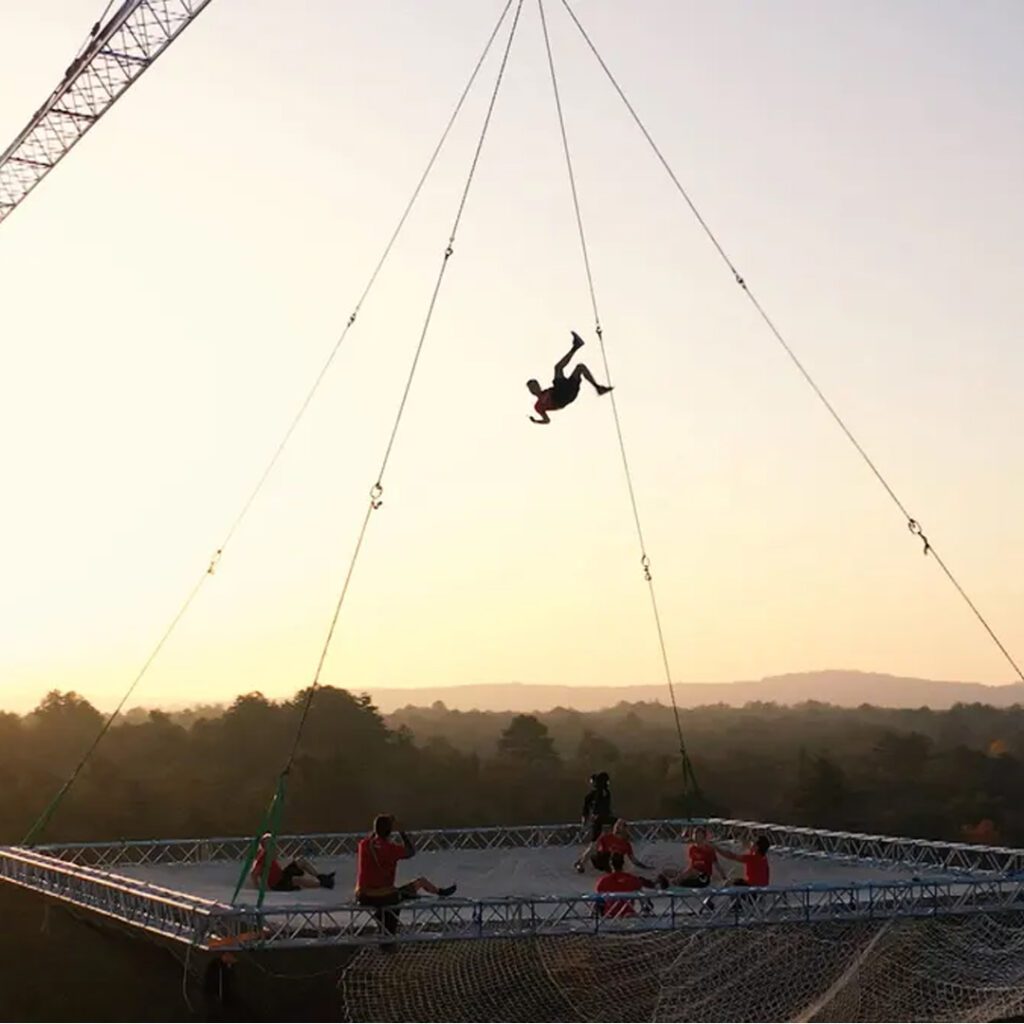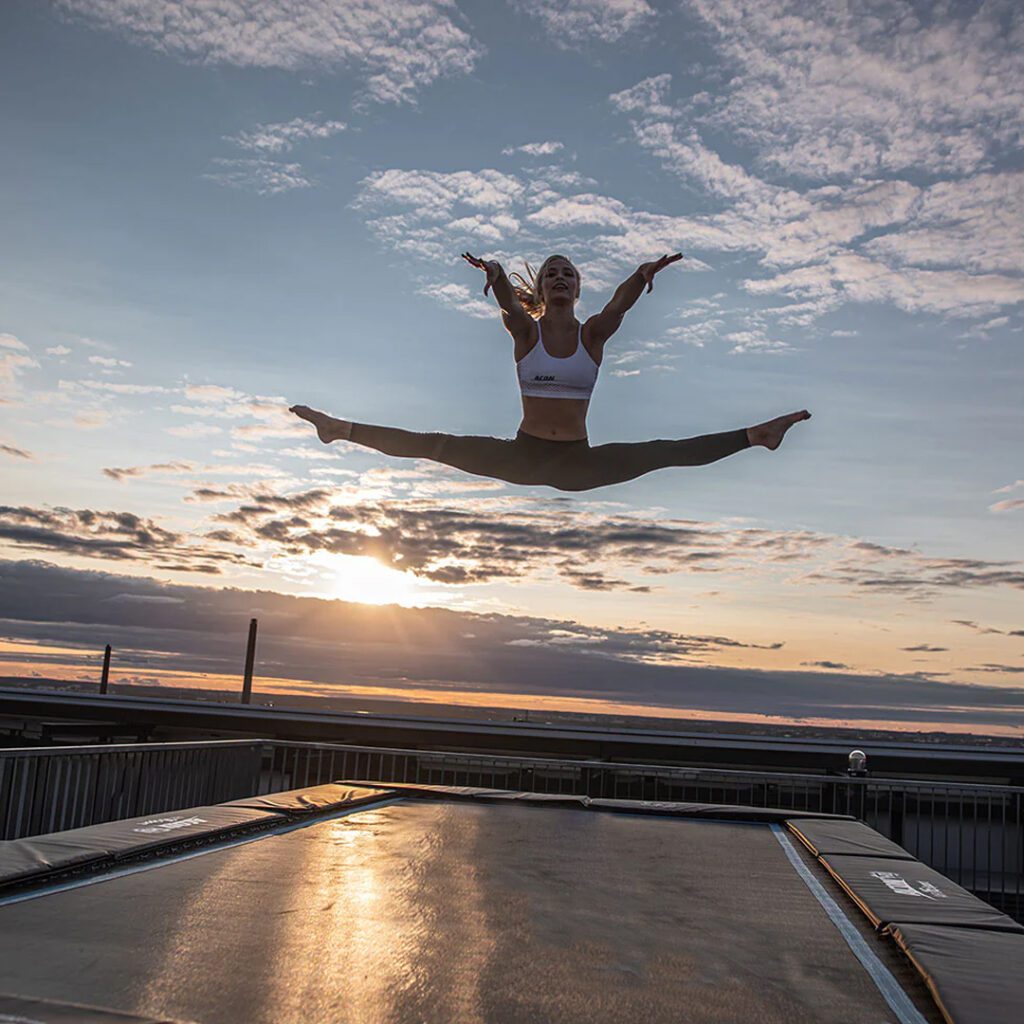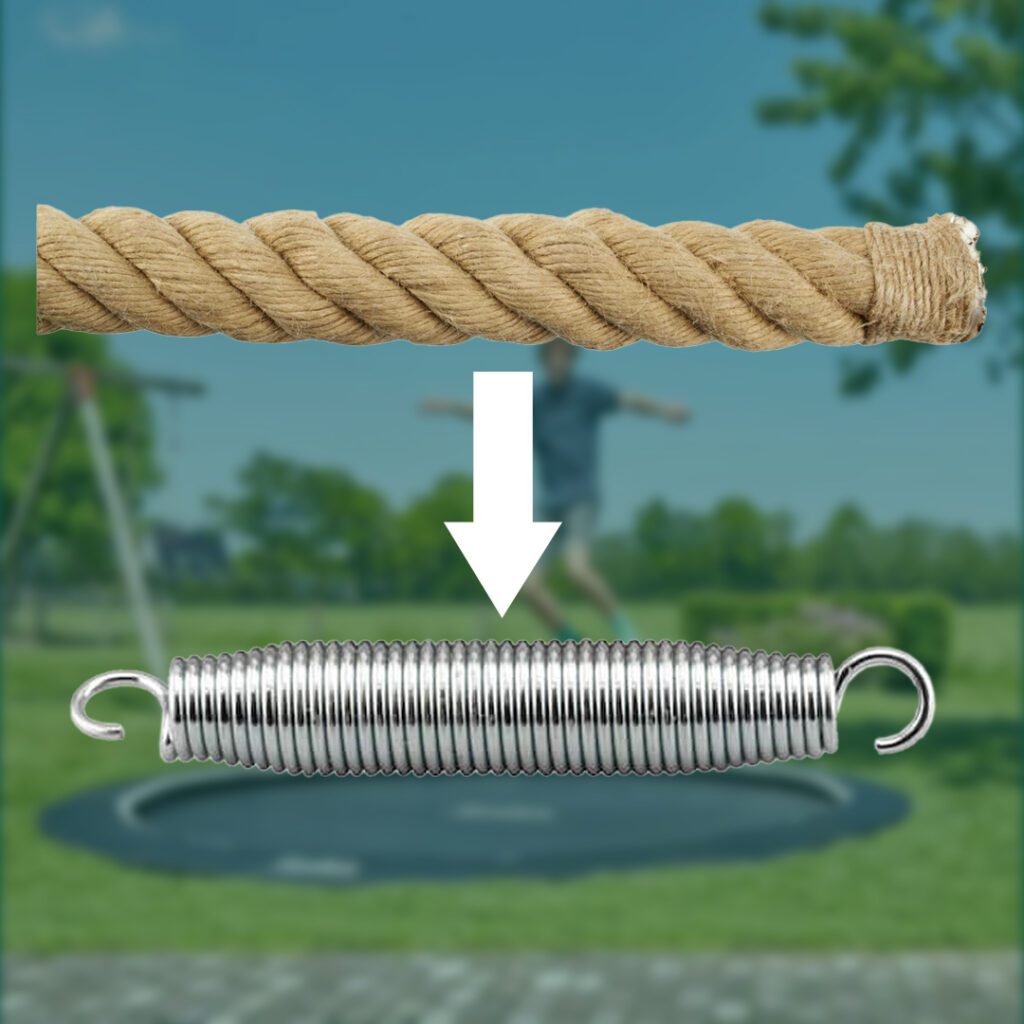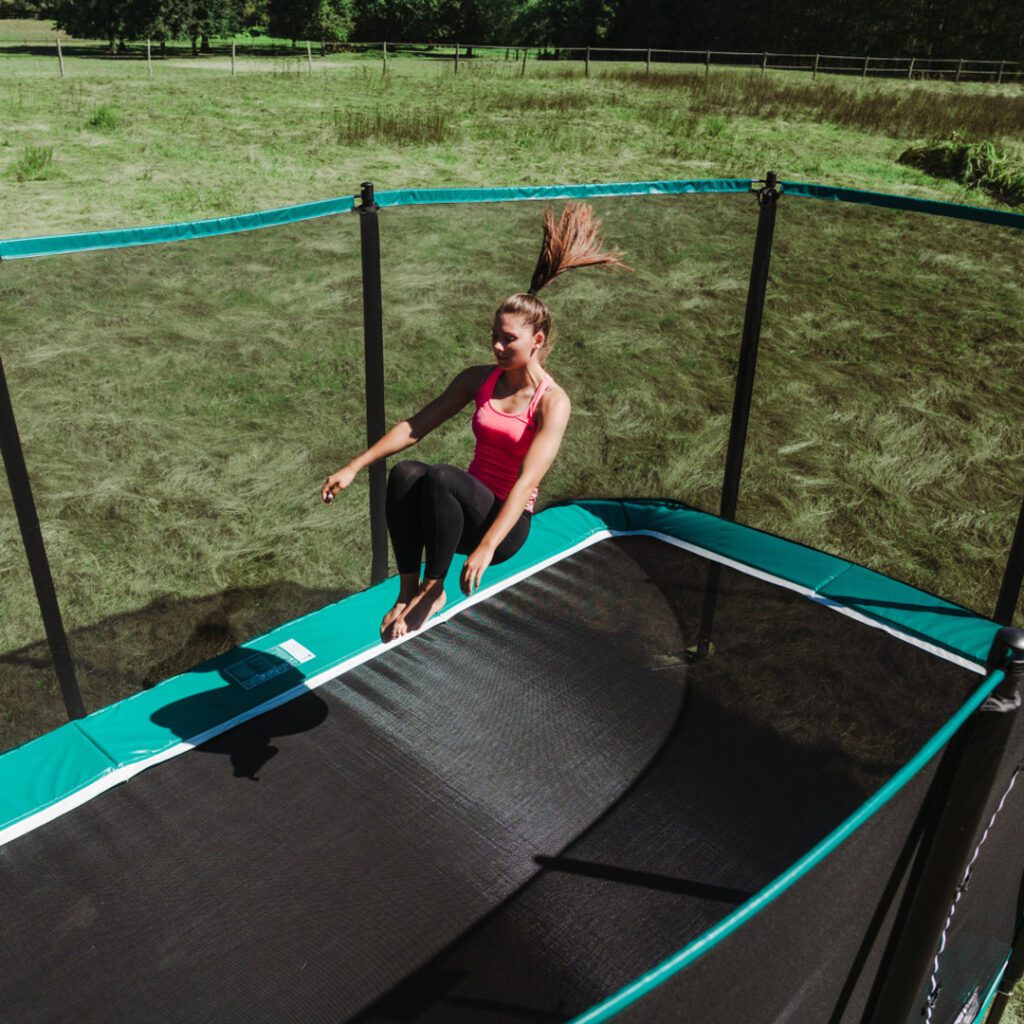
Trampolines are a classic way to bounce your way to fun and fitness. But there’s a lot you may not know about these familiar recreational devices. For instance, did you know trampolines originated as training tools for astronauts and pilots? Or that you can find trampolines made specially for dogs? You’ll learn about their surprising history, different types and uses, record-setting jumps, and more. You may even be inspired to take a bounce yourself after discovering how a family trampoline can improve your health.
Whether you’re already a trampoline fan or have never tried one, you’re sure to be entertained by these 30 interesting facts about trampolines.
1. The largest trampoline in the world is over 1,500 square feet

The “Dunking Devils Squad” from Slovenia made the “world’s biggest trampoline.” It’s in Sežana and measures over 1,500 square feet. They hung it 100 feet high. People can bounce on it and feel like they’re flying over 130 feet in the air! They used 300 springs and lots of netting to make it safe.
2. Trampolining used to be an Olympic sport
Trampolining was an Olympic sport in the 2000 Sydney Olympics and 2004 Athens Olympics. Medal events included individual and synchronised sport trampoline routines. Trampolining was a demonstration sport in the 1996 Atlanta Olympics and 2012 London Olympics.
3. The British began the first organised trampolining competitions
The British began organising national trampolining competitions and events in the 1950s and 1960s. This helped popularise the sport and led to the founding of the British Gymnastics Association Trampoline Committee. The first Trampoline World Championships were held in London in 1964.
4. Trampolines can launch humans up to 20 metres high

The world record for the highest trampoline jump is 20 metres (65 feet), set in 2012 by British duo Blake Aldridge and Thomas Daley. However, such extreme heights are very dangerous and not recommended for recreational trampoline use. Most recreational trampolines will only launch an average adult 3-5 metres (10-15 feet) high.
5. Trampolines were developed from medical devices
The modern trampoline originated from medical equipment used to help patients with bone and muscle conditions. Doctors would prescribe “rebound therapy” using trampoline-like devices to help patients improve balance, coordination and muscle tone. Over time, these medical trampolines evolved into the recreational trampolines we know today.
6. Some world records involve trampolines
Trampolines have been used to set some unusual world records. The highest trampoline dunk record stands at 10 feet 7 inches, set by high-flying slam dunk artist Jamal Edwards. Meanwhile, the longest time spent bouncing on a trampoline continuously is over 25 hours, achieved by Australian teenager Ashley Watson. And the record for the most consecutive forward somersaults on a trampoline is 1,000, held by British gymnast Ruth Rose.
7. Trampolining improves fitness and motor skills
Besides being fun, trampolining provides a full-body workout that can improve fitness, balance, coordination and motor skills. Regular trampoline use can strengthen core and arms while also improving cardiovascular fitness. Trampolining also challenges the vestibular system to improve balance and spatial awareness.
8. Children and adults can benefit from trampolining
Both children and adults can enjoy the health benefits of trampolining. For children, trampolines improve coordination, balance and bone strength while burning excess energy. For adults, trampolines offer a low-impact cardio workout that strengthens muscles, relieves stress and improves mood. With proper safety precautions, trampolines can be enjoyed by all ages.
9. Trampoline parks are growing in popularity
Trampoline parks offer open jump time and recreational activities on large trampolines. Trampoline parks feature many exciting activities like foam pits, dodgeball courts, trampoline basketball, and aerial stunt equipment like bungee ropes and trapeze rings. Trampoline parks have grown rapidly in recent years and now exist in many cities worldwide. They provide an enjoyable way for families and friends to be physically active together.
10. Bounce houses are a type of inflatable trampoline
Bounce houses, also called “jumping castles” or “inflatable bouncers”, are large inflatable structures designed for children to jump inside. They work on the same rebounding principle as trampolines, using elasticity and tension to launch children into the air with each bounce. Bounce houses come in a variety of shapes and themes to appeal to children.
11. Trampolines promote weight loss

Jumping on a trampoline provides an intense cardiovascular workout that elevates heart rate and burns calories. Just 15 to 30 minutes of trampolining can burn 200 to 300 calories for most adults. The rebounding action also helps tone muscles and improve coordination.
12. The shape of trampolines has evolved over time
Early trampolines were circular, but rectangular trampolines eventually became more popular due to their larger jumping surface. Today, trampolines come in a range of shapes, including round, rectangular, and square. Some even have irregular shapes with cutouts.
13. Trampolines can relieve back pain with “rebound therapy”
Jumping on a trampoline in controlled movements can help relieve back pain through a therapy known as “rebound therapy”. The rebounding motion decompresses the spine and can stimulate the lymphatic system for healing.
14. Trampolines improve bone density
Jumping on a trampoline places high impacts on bones, which helps build bone density and reduce the risk of osteoporosis later in life. Trampolines are especially beneficial for preteens since their bones are still growing rapidly.
15. Steel springs replaced hemp ropes for trampolines

Early trampolines used hemp ropes to provide tension, but steel springs eventually became the standard due to their consistency, strength and durability.
16. Foam pads and safety nets improve trampoline safety
Trampoline pads that surround the trampoline frame and safety enclosure netting enclose the jumping surface have been added to trampolines to improve user safety. These features help cushion falls and prevent jumpers from falling or jumping off the trampoline.
17. Professional stunts often involve trampolines
Many professional stunts in movies, TV shows and live performances use trampolines to provide height, momentum and flips. Stunt performers rely on trampolines for high-flying action scenes.
18. Trampolines improve cardiovascular health
Jumping on a trampoline provides an aerobic workout that raises the heart rate and improves cardiovascular fitness. Trampolining can help lower blood pressure and cholesterol while strengthening the heart muscle.
19. Different jumping tricks and moves are possible on trampolines

Beyond just jumping, trampoliners can perform tricks like tucks, pikes, straddles, seat drops and somersaults. With practice and training, more advanced skills become possible.
20. Trampolines help improve balance and coordination
The bouncing and rebounding from a trampoline challenges the body’s sense of balance and coordination. This results in improved body awareness, posture and overall proprioception.
21. Trampolines improve reaction time and reflexes
The fast bouncing and rebounding from a trampoline challenges the body’s reflexes and reaction time. This results in improved agility, hand-eye coordination and overall responsiveness.
22. Trampolining relieve stress and tension
The rhythmic bouncing motion and feelings of joy from jumping on a trampoline can help reduce stress, tension and negative thoughts. Trampolining provides a mental break that leaves one feeling refreshed.
23. Trampolines can improve sleep quality

The movement from trampolining activates the vestibular system which helps regulate the body’s sleep-wake cycle. Jumping on a trampoline can raise levels of melatonin, the sleep hormone, which results in better sleep quality and quantity.
24. Trampolines improve leg strength
Jumping on a trampoline engages the leg muscles, including calves, quadriceps and hamstrings. Regular trampoline use can lead to significant gains in leg strength, endurance and muscle tone.
25. Trampolines help improve agility and quickness
The jumping, landing and changing direction on a trampoline challenges the body to develop quicker reactions and move in an agile manner. This translates to improved sports performance.
Conclusion
To wrap up, trampolines aren’t just about fun – they’re full of cool surprises! They were first used to help astronauts train and some are even made for dogs! The biggest one in the world is like a massive playground! But, watch out – jumping too high can be risky! Trampolines started as medical tools but turned into the fun ones we know today. Bouncing on a trampoline isn’t just enjoyable; it’s like giving your whole body a workout! Trampolines are for everyone, whether you’re a kid or an adult. So, whether you’re doing flips or just bouncing around, trampolines are a super fun way to stay active!





